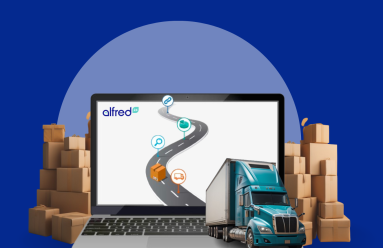Mastering Last-Mile Delivery in E-Commerce

In the realm of global commerce, the last-mile delivery sector has risen to unprecedented prominence, fueled by the explosive growth of e-commerce and further accelerated by the transformative impacts of the COVID-19 pandemic.
Last-mile delivery, often overlooked in traditional supply chain narratives, has now become the linchpin for retailers navigating the evolving landscape of consumer expectations.
The Global Last Mile Delivery Market, currently valued at US$ 79.9 billion, stands on the precipice of a transforming, projected to reach an estimated US$ 137.4 billion by 2030.
This surge symbolizes market expansion and the sector’s pivotal role in meeting the escalating demand for efficient, timely, and customer-centric last-mile deliveries.
Join us on a deep dive into the critical role played by last-mile delivery in sculpting the customer experience and its profound impact on a retailer’s standing in the fiercely competitive market.
Exploring the Last Mile Journey
In the intricate web of logistics, last-mile delivery, also known as final mile delivery or final mile logistics, plays a pivotal role.
It’s the critical phase where goods traverse from a warehouse or distribution center to their ultimate destination, often concluding at the customer’s doorstep.
This essential part of the delivery process is all about connecting sellers with end consumers, ensuring a smooth and efficient journey for ordered items.
The Ascendance of E-Commerce
- Online Surge in 2023:
- Expect 20.8% of retail purchases to happen online, showing a big shift in how people buy
- Rising Trend till 2026:
- By 2026, online buying will likely grow to 24%, proving it’s not just a fad but a lasting change
- Sales Growth in 2023:
- E-commerce sales are set to jump by 10.4% in 2023, driven by more people shopping online
- Global Market Expansion:
- Worldwide, the e-commerce market is predicted to hit $6.3 trillion in 2023, offering global opportunities
- Future Growth to $8.1 Trillion:
- Looking ahead to 2026, the global e-commerce market is expected to exceed $8.1 trillion, emphasizing its long-term significance
- U.S. E-commerce Boom:
- The U.S. e-commerce market will soar past $1.1 trillion in 2023, creating great opportunities for national sales
- Online Shopping Norm:
- In the U.S., 16.4% of retail purchases are set to be online in 2023, reflecting the norm of online convenience
Last Mile Delivery Post-COVID-19
- Surge in Online Retail:
- Anticipating a significant 20% growth in online retail share by 2023, this projection signals a fundamental shift in consumer behavior, accelerated by the transformative effects of the pandemic
- Rapid Rise of Instant Delivery:
- Highlighting a noteworthy 10% annual growth in instant delivery, this projection underscores heightened consumer demand for immediacy and convenience, aligning with the accelerated pace of modern life
- Autonomous Vehicles Taking Center Stage:
- Envisioning a futuristic landscape, the forecast indicates the mainstream adoption of autonomous vehicles by 2024. This hints at the integration of cutting-edge technologies to streamline and revolutionize the last-mile delivery process, promising advancements that could redefine the industry
Challenges of Last Mile Delivery
- Financial Strain
- Logistical Hurdles
- Last-mile distribution faces challenges like customer location, delivery routes, and time-definite windows
- Inventory shortages, tracking discrepancies, and routing errors contribute to process inefficiencies
- Reputation Impact
Trends Shaping Last Mile Delivery
- Gig Economy & Crowdsourcing
- Startups like Uber, Postmates, and Roadie leverage crowdsourced delivery services
- Challenges include urban-centric adoption and concerns over oversight and efficiency
- Smart Technology for Tracking
- Smart technology enhances transparency, using GPS, RFID tags, and IoT-enabled sensors for real-time traceability
- Provides customers with precise location and environmental condition updates
- Robotic Delivery
- Retailers experiment with self-driving vehicles, drones, and autonomous bots to reduce labor costs and enhance availability
- Amazon’s substantial investment in autonomous technology underscores its potential
- Rapid Order Fulfillment
- Amazon’s influence on rapid order fulfillment prompts retailers to optimize delivery windows
- Partnership with third-party logistics providers utilizing warehouse management systems is a viable strategy
- Urban Warehouses
- The shift towards urban warehousing is driven by the need for rapid order fulfillment, placing fulfillment centers closer to end consumers
- Urban warehouses offer benefits such as reduced delivery lead time and closer access to labor pools
- Insourcing Deliveries
- Some retailers opt to handle last-mile delivery internally, utilizing their fleet of vehicles or engaging in collaborative efforts with competitors to share assets and reduce costs
- Hybrid Fleet Management Systems
- Adopting hybrid fleet models, combining a company’s fleet with contractors and third-party providers, offers scalability and affordability
- A hybrid fleet management system provides real-time optimization, including routing, vehicle monitoring, and weather alerts
- Last-Mile Upselling
- Last-minute upselling leverages predictive technology to pitch additional items to customers during delivery
- Delivery drivers carry additional items for potential upselling opportunities, capitalizing on customers’ impulse buying tendencies.
- Predictive Shipping
- Retailers use predictive algorithms to analyze seasonal trends and pre-position stock in local warehouses, reducing delivery time and shipping cost
The Impact on Retailer Reputation
- Last-mile delivery is a proving ground for retailers, shaping the customer’s end-to-end experience
- The experience reflects on a retailer’s brand, and successful last-mile strategies contribute to an enhanced reputation
Optimizing Last Mile Delivery through Third-Party Logistics Providers
Forming partnerships with specialized third-party logistics (3PL) providers becomes highly advantageous to meet the increasing demands for on-time delivery.
These 3PLs offer extensive expertise, dedicated resources, and advanced technologies specifically designed to optimize the last mile of delivery.
Their proficiency in route optimization, white glove delivery services, efficient inventory management, and exceptional customer service can substantially enhance a company’s capability to fulfill on-time delivery commitments.
Through a strategic alliance with a reliable 3PL partner, businesses can concentrate on meeting consumer expectations for timely deliveries while gaining the benefits of efficient logistics operations and improved scalability.
Conclusion
Statistics Source: Market Research Resources – Blog by Aaron Zofkie.


